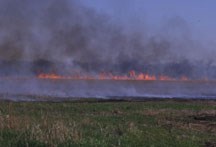
After climate, fire is the next most important determinant in the spread and maintenance of prairie grassland. Fire interacts with other factors that influence grassland and determine vegetation patterns. Grasses are generally better adapted to drought than most tree species. Grasslands include climates with periodic drought that permits the vegetation to dry. Lightning which easily sparks the driest regions of prairie started the first fires thousands of years ago. The Red BuffaloThis was the name given to prairie fire by tribes of plains Indians before European settlement. Most ecologists agree that for the last 5,000 years, prairie vegetation would have diminished if not for the burning of these grasslands. The American Indian observed that prairie burned by lightning strikes would soon yield green pastures. By mimicking nature and burning the prairie in desirable locations, the growth of fresh shoots of highly nutritional native grasses was insured. Therefore, the hunter-gathers and later organized tribes of Plains Indians were North America’s first large-scale land managers. |
Last updated: October 27, 2021
